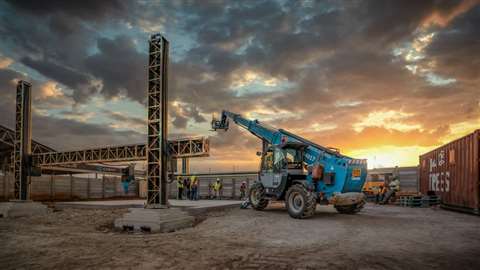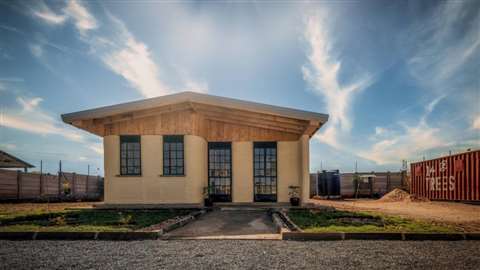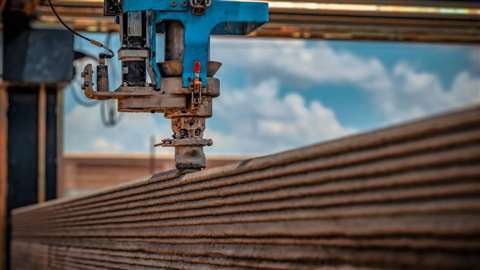3D printing: New tech being used to build in Africa
23 June 2022
Holcim subsidiary 14Trees is the first firm to use 3D printing to build schools and affordable housing in countries across Africa. Managing director François Perrot tells Lucy Barnard how the new technology is helping to house and educate some of the world’s poorest
It may be night time in the Kenyan town of Kilifi but construction work is going at full speed at the Mvule Gardens housing complex construction site, half a mile from the Kilifi Highway on the outskirts of town.
As the huge African sun sets over the surrounding countryside, a giant blue nozzle on a long robotic arm, supported by a metal gantry, continues its journey travelling round and round a plot of land, piping out a think layer of concrete, like a line of toothpaste, as it goes.
At each rotation, a concrete structure underneath the nozzle grows a couple of inches taller. By the time the sun rises again over the nearby Indian Ocean, the main structure will be built.
 The 14Trees team sets up its COBOD 3D printer. Photo: Holcim
The 14Trees team sets up its COBOD 3D printer. Photo: Holcim
The project, which is being built by African construction company 14Trees, a joint venture between Swiss cement manufacturer Holcim Group and the UK government’s development arm, British International Investment, is Africa’s largest 3D-printed affordable housing project.
For François Perrot, managing director of 14Trees and head of affordable housing at Holcim, the continent of Africa, with its massive and growing demand for homes and schools, is an area where 3D printing technology can really make a difference.
Construction using 3D Printing
He says that Malawi alone needs to build more than 40,000 classrooms to meet the needs of the current population – something that would take more than 70 years if it relied on conventional construction methods but which, if 3D printing methods were widely adopted, could be completely cleared in just a decade.
And, with international charity Habitat for Humanity estimating that four in five families in the country live in sub-standard housing, the need for more affordable housing is, if anything, even more acute.
“The way we build with bricks is a slow process. Putting bricks on top of each other takes time. If we have to wait 70 years then the children who are born this year would never have a chance to go to school in Malawi – that’s the consequence,” Perrot says.
“So, we said, how can we disrupt and make sure that in the next ten years we clear that backlog of 40,000 classrooms? What is a technology that will make this possible? There was only one technology that came out as having the potential to eradicate that backlog and that was 3D printing.”
Speed of 3D printing
To that end, Perrot has refocused the company towards scaling up its 3D printing operations. In 2020, the company built the world’s first 3D printed school in Malawi’s Salima district and in June 2021 it completed Africa’s first 3D printed affordable home in the capital, Lilongwe, printing the walls in less than 12 hours.
Although 14Trees is growing its client list of charities, NGOs and private real estate developers, Mvule Gardens is the company’s largest scheme so far, comprising 52 one-, two- and three-bedroom houses arranged in a net square of cream coloured concrete.
Like 14Trees’ other projects, it is being printed by a single transportable printer built by Danish manufacturer COBOD, mounted on four horizontal beams and supported by four vertical legs. The printer is fed by a Holcim-patented mix of dry cement, aggregates and chemical admixtures to which pressurised water is added from a pump, mixed with the cement mixture and pushed into the nozzle. A computer then directs the printer, controlling the nozzle as it squirts out 5cm wide, 2cm high layers of concrete one on top of the other.
 A show home at the Mvule Gardens housing complex in Kenya. Photo: Holcim
A show home at the Mvule Gardens housing complex in Kenya. Photo: Holcim
Using the system, the printer can build a single house or even a block of two semi-detached homes in 12-18 hours.
Even though the main structures of buildings can be completed in just a few hours using the new technology, Perrot says that when the rest of the construction process is added, the entire process takes around a month to complete.
Although there are no bricks to lay on the site, a team of carpenters, electricians and plumbers is still required afterwards to install the windows and doors, put on the roof and connect the services.
Is 3D printing the future of construction?
“The most optimal process is to excavate, pour the foundations, let them cure, then print, then let it cure a couple of days, then put the roof on, and then your house is finished,” he says. “If we want to rush, we can do it in one month. The key part, the one that is really shorter is the construction of the walls. That usually takes months. I should say weeks, but the reality in Africa is months and that’s what we reduce to just a couple of hours.”
Although he estimates that construction costs for 3D printed buildings currently stand on a par with those built using conventional methods, Perrot and his team plan to reduce costs to stand between 15 and 20% cheaper than their traditionally-built counterparts.
He plans to do this by scaling up the business so it can print more and bigger projects as well as by streamlining the way the team operates to remove inefficiencies.
“The economies of scale that we can get with 3D printing are massive,” Perrot says. “The savings that we generate on 3D printing are with the design of the building, the speed and the quantity of materials. That is where the savings are huge in Africa. When we print a larger project we only need to twist the printer and then start printing the second house and then move it a little bit to the next batch. That is where we will start to see the benefits.”
Perrot’s team is also continually working to improve the design of the homes it prints. Last year the company modified its housing designs to ensure that the printed walls are fully load-bearing, meaning that they no longer need to use steel columns to support the structure. The company has also included a cavity wall for insulation. Now it is experimenting with printing roofs, either in situ or printing them separately and hoisting them into position to replace the traditional roofs of tiles or roofing sheets which it is currently using.
“What drives us is the affordability of the building,” Perrot says. “It’s not about building the most fancy building, it’s about having a building that can be affordable for as many people as possible in that country. So, what will win is not the most technical solution, it will be the most affordable. That’s what will decide.”
Latest 3D printers
To further ramp up production, 14Trees plans to invest in a number of new 3D printers, reducing the time and money required to move the printer across the continent and enabling the company to print several projects at one time. The company is also looking at improving its processes for mounting and demounting the printer which currently takes a day each time and currently requires the use of a telehandler – a machine which is not always readily available in remote African villages.
 14Trees uses a COBOD 3D printer. Photo: Holcim
14Trees uses a COBOD 3D printer. Photo: Holcim
Each printer requires a team of two people to operate it, one to operate the machine itself and the other to provide maintenance. Perrot says that 14Trees is currently training new operators to support its original team, providing jobs and training in the local economies for both men and women.
“The printer operators are Malawians that we trained in Malawi so that’s really people that we grew from the start to manage that activity,” he says. “The people that support that team are recruited locally in the villages where we print the school, or the house and they are trained too. Last time we printed it was Madagascar, we managed to reach 25-30% of women that were on the job site while usually in Africa on construction job sites this is zero.”
“3D printing is all about knowing how to behave on a construction jobsite,” Perrot adds. “Learning how to use the printer is rather straightforward as long as you are given the opportunity to use the tool. It’s quite quick because the safety risks are reduced. With the first project it took them roughly a month to really be able to fully operate the printer in an efficient way. I believe that now it could be done in a week.”
Moreover, even though the buildings 14Trees is printing are almost entirely made from carbon-intensive concrete, Perrot says that the fact that they are made by computer means that none of the material is wasted and mistakes are eliminated, significantly reducing their CO2 footprint.
Reduction in concrete CO2
“What’s important is to use concrete with the full power of what concrete can deliver,” he says. “Yes, we do still use cement in the ink but the quantity of material we use is very much reduced. So when you do a life cycle assessment, you still have a 50 to 70% reduction in CO2 compared with conventional buildings because you use that cement in a way which is more optimal.”
And, Perrot says, as more and more clients start to see 3D printed buildings being built and used, the more the technology will start to take off – at least for some sorts of structures.
“What you can see, what you can feel when you start 3D printing those buildings is that it is just the beginning,” he says. “It’s almost like at the end of the 1990s when we were starting to have the internet at home. That was not the internet as we know it today, like the video conference we are having, but we could see there was something coming. And that’s a bit the same with 3D printing. You see that the potential related to the way we use computers to improve the efficiency of construction sites and it is just limitless.”
STAY CONNECTED



Receive the information you need when you need it through our world-leading magazines, newsletters and daily briefings.
CONNECT WITH THE TEAM








